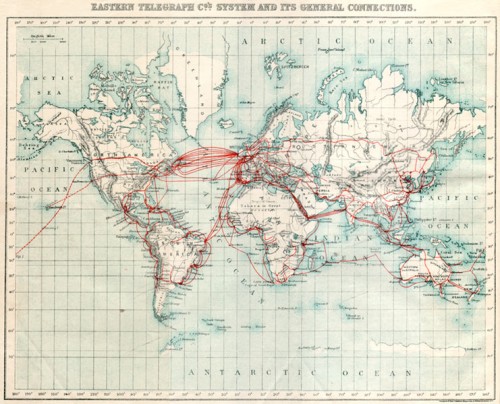Seychellois President speaks on SEAS cable
The Seychelles East African Submarine cable plan is a perfect example of how every African nation must adopt unique methods to suit its goals.

Seychelles was first connected to Tanzania by the Eastern Telegraph cable. This 1901 map shows the connection to the mainland. Wikimedia Commons}
IT is the future in this modern, evolving world. To me, this is the future: the new Seychelles we are creating.” – President James Michel, November, 2010
With Internet access in 1996 and 2,000 subscribers by 2000, the small island nation of Seychelles has always been a vanguard when it comes to ICT. In fact, Seychelles was even connected via dial-up to France via RIONet in the early-mid 1990’s. However, despite SAFE and LION cable landing points in nearby Reunion and Mauritius, Seychelles remains unconnected to fixed broadband. Even so, Seychelles boasts the highest Internet penetration rate in Africa (at least according to June 2010 ITU stats).
Still, connection speeds are lacking and much of the Internet use comes from corporate and government users rather than schools and home users. Fortunately, Seychelles will welcome an all-new 2000km undersea fiber-optic cable in less than two years. The USD $34 million Seychelles East Africa Submarine cable will connect Seychelles with Dar es Salaam and is expected to strengthen government services and educational capacity, among other things.
How did the nation prepare for and secure the SEAS cable? Privatization, a confident government, and some impressive planning:
- Privatization of the telecoms market. The Seychellois company behind the cable, Seychelles Cable System, consists of both the government and two telecommunication operators.
- October 2007: Launch National ICT Policy based on five guiding principles: ICT Infrastructure, Legal and Regulatory Framework, Human Resource Development, ICT Industry, and Government.
- Early 2009: Secured Technical Assistance Grant from a branch of the African Development Bank.
- April 2009: Initiated a pre-investment analysis study to determine feasibility, ownership, business model, financial model, and environmental impact.
- Late April 2009: International Finance Corporation announces support of Seychelles cable project.
- March 2010: Feasibility study for three options completed. The “direct-build” project is determined to be the most viable.
- August 2010: Bharti Airtel announces USD $10 million investment over 3 years. The telecom operator also announced participation in the SEAS cable.
Such progress is very impressive and President Michel certainly should be proud if his nation can have operational broadband by late 2012. In a recent Seychelles Nation article, quotes by the president repeatedly stress the importance of government. Perhaps the Seychellois government has less on its plate than larger and more socially complex nations. Regardless, other leaders should view the SEAS cable as an example of the kind of thought process needed to ensure a brighter future for their nation.












 Twitter
Twitter Facebook
Facebook Pinterest
Pinterest